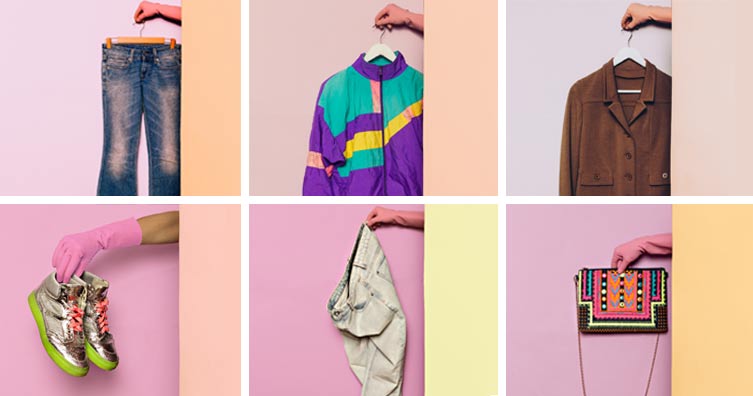Best places to sell clothes online
Selling clothes online can be a great way to clear up your crammed wardrobe, get rid of last season's fashion and make some extra cash while you're at it.

You're staring at a wardrobe filled with clothes. Yet, somehow, you still have nothing to wear. If you find yourself hoarding piles of clothes you never use, it's time to clean out your closet and make some cash in the process.
Selling clothes online is easier than ever. Some apps and services have streamlined the process so even if you're new to the game, you can start making money instantly.
We've put together a list of the top places to sell clothes online. On top of that, we've got some tips to help you make the most of your wardrobe.
Top sites for selling your old clothes
These are the best places to sell clothes online:
-
Vinted
- Best for – Everything, but upmarket high street brands (think Zara, Mango and even H&M) often do well
- Charges – Free to sell (buyers are charged a fee though).
Vinted is a huge online marketplace for selling clothes, with millions of users. To sell, you upload your items, set the price and ship the items when they're sold.
Vinted has a pretty varied target audience. There's a good number of students and young people on the app, but also some older groups. You shouldn't have much trouble making a sale, no matter your fashion style.
As with most platforms for second-hand clothes, if you have bought anything recently that doesn't fit, it's more likely to sell than something from a few years ago.
Check out our Vinted selling tips for more info and advice, and start making your mini fortune.
-
Depop
- Best for – Pretty much everything, but vintage and quirky items sell best
- Charges – For all newly listed items since 20th March 2024, Depop has removed the 10% selling fee for UK sellers. However, there's still a payment processing fee of 2.9% + £0.30. Buyers will also be charged a marketplace fee from 15th April 2024.
When it comes to finding the best sites and apps to sell (and buy) clothes online, Depop is a popular choice.
The app is designed in a similar way to Instagram. You upload a picture of your item in the usual square format (you can upload a series if you want) and add a caption. It's best to include details like the condition and description of the clothes you're selling.
Depop also gives you the option to set prices and select the item size. For newbie sellers, the process of uploading images of your clothes and making your first sale is super easy.
You can sell pretty much anything that's in your wardrobe here. However, vintage items are often popular, as are high-street clothes that have sold out in-store.
It's possible to sell shoes, jewellery and even lifestyle items like posters, old books and records. You can also make arrangements with other sellers to swap items if you agree on a deal.
Find your niche, build a mini-brand and expand your followers. Believe us, selling on Depop is even more addictive than scrolling on Instagram.
-
eBay
- Best for – Selling a wide variety of things
- Charges – 12.8% charge on all sales plus a fixed charge of 30p per order plus a 35p listing fee for any listings over the free monthly allowance of 1,000. For the full list of fees including ones for optional listing upgrades, see eBay's website.
eBay attracts millions of visitors every day, making it a great option for selling clothes online.
The benefit of using eBay is that you can sell pretty much anything there. That can also be the downfall, though. To optimise your selling technique, try to find out what people are searching for. Find niche markets or demands and create listings that target key search terms.
There are two selling options to go for.
'Buy It Now' lets you set a non-negotiable price.
Alternatively, if you opt for an auction, buyers can place bids. This could mean your clothes sell for more than you expected. Plus, you can set a starting bid, which means the item won't be sold for a price you're unhappy with.
If selling your clothes via an auction, try to schedule your bidding to close on a Sunday. This has previously been reported to be the busiest day of the week for the site.
Check out our eBay selling tips for more tips to maximise your profits.
-
Preloved
- Best for – Selling your clothes online locally
- Charges – Free.
Preloved is a free classified ads site that lets you list things to sell in your local area. It's also one of the largest classified sites in the UK, with an audience of millions.
The best thing about Preloved is there are no fees whatsoever and there's a strong emphasis on location. This means you might be able to sell clothes to people in your area and save money on postage.
Make sure you fill in your profile so people know you're a reliable (and real!) person. You also get a limited number of free pictures per ad, so use them wisely.
-
Facebook Marketplace
- Best for – Selling locally
- Charges – Free.
While Facebook Marketplace isn't known for being the most successful platform for selling clothes online, it is mostly free.
We say "mostly" because there's a potential standard selling fee if you use Commerce Manager to sell things on Facebook or Instagram. Find out more in our full guide to selling on Facebook Marketplace.
The Marketplace lets you upload items, but it's also been merged with Facebook selling groups.
These groups are usually specific to certain locations, like towns or boroughs. This means you can potentially cut out postage costs by selling to people living close enough to collect the items.
Don't count on getting a great response for high-quality vintage or niche items. But if you're selling a large bundle of clothing, this might be a good way to do so quickly and without charges.
Facebook Marketplace is also one of our favourite places to find cheap shoes and trainers. -
Etsy
- Best for – Selling homemade and vintage items
- Charges – £0.16 listing fee, 6.5% transaction fee and 4% + £0.20 as a payment processing fee.
You might associate Etsy with selling homemade craft items rather than second-hand clothes. But if you make your own or upcycle clothing, this could be a great way to stand out from the crowd.
Printed t-shirts or hand-embroidered vintage clothing, for example, are great things to sell on Etsy. Homemade jewellery and badges are also great for this site.
Etsy does have strict rules on what you're allowed to sell, so check the small print first.
-
ASOS Marketplace
- Best for – Clothing entrepreneurs
- Charges – 20%.
Note: At the time of writing, ASOS Marketplace isn't currently accepting applications. Keep an eye on their website in case this changes.
ASOS Marketplace isn't for newbies or those looking to make an extra few quid by selling their last season cast-offs. Instead, it's for dedicated clothes sellers looking to establish their businesses (or those who already have one).
To get started, you need to apply for a boutique. They'll only consider you if you make your own unique clothing, have a large selection of high-quality vintage garments or you've already established yourself as an independent fashion label.
Compared to other options listed here, it's quite pricey (and, as a buyer, your TOTUM card won't work in the Marketplace). But if you're determined to have a career in high-end or retail fashion, having access to a huge audience on ASOS is a major plus.
Tips for selling clothes online
Try these tips to sell clothes for the best possible price:
- Take clear photos of your items – Use a good quality camera and make sure there is natural light. If possible, take a photo of someone wearing the item. This will make it easier for buyers to visualise what the item will look like when worn.
- Find a niche – Do you have a particular style such as retro or vintage, or large quantities of a certain item like trainers or jewellery? If your store has a theme, you can attract loyal customers who will return to your store.
- Maintain a good reputation – Be honest about the quality of the clothes you're selling, including if there are any stains or tears. Always respond to messages and feedback. You could even add a handwritten note with the packaged item thanking the buyer for shopping with you.
- Make your clothes presentable – It goes without saying, but give your items a good wash and an iron before you sell them.
- Ensure your descriptions are accurate – Make sure the sizes you're advertising are spot on, and if something's labelled as a size 12 but feels more like a 10, let shoppers know.
- Keep up with fashion trends – Certain types of clothes will come in and out of style, so jump on top of trends and make some cash from them.
- Think seasonally – Festival wear will sell better in summer, while people are more likely to shop for woolly coats in winter. If you're selling to an international audience, keep their seasons and climates in mind too.
- Be realistic about pricing – You're unlikely to sell second-hand clothes for the price you bought them for. Don't scare customers off with high prices.
- Don't lose money on the postage – Check postage prices in advance and add that on top of the advertised selling price (most sites will have a separate section for this). You can splash out on tracked or signed for delivery, but as a minimum, keep hold of the proof of postage in case something goes wrong and your parcel doesn't arrive.
Don't forget that charity shops are always looking for old clothes. If you can't sell some items or you're feeling generous, consider donating your pre-loved garments to a worthy cause instead.
Our guide to the best side hustles has more money-making ideas – plus some info about paying tax on your earnings.















